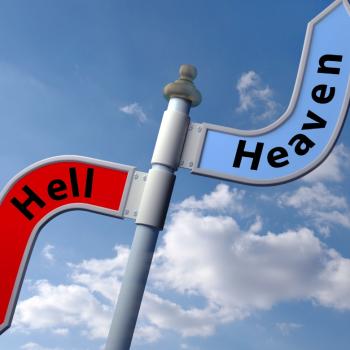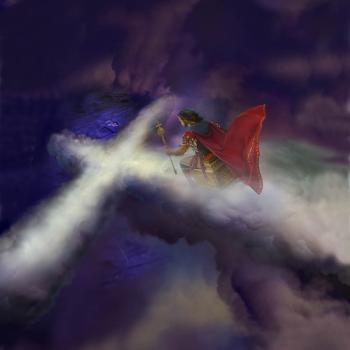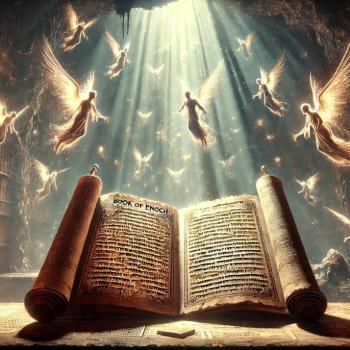 My book, Warrior from Heaven, has an image of Jesus on a throne and riding on bright-shining clouds that are shaped like a cross. When I wrote this book, I hired a New York graphics artist to draw this image that I had sketched out. It’s one of my most favorite outcomes of my literary career. It is based on what Jesus said in his Olivet Discourse.
My book, Warrior from Heaven, has an image of Jesus on a throne and riding on bright-shining clouds that are shaped like a cross. When I wrote this book, I hired a New York graphics artist to draw this image that I had sketched out. It’s one of my most favorite outcomes of my literary career. It is based on what Jesus said in his Olivet Discourse.
During Passion Week, Jesus and his disciples were on the Mount of Olives overlooking Jerusalem. His disciples marveled at the beauty of the temple buildings below. According to Matthew (NRSV), Jesus said, “Truly I tell you, not one stone will be left here upon another; all will be thrown down” (Mt 24.2; cf. Mk 13.2; Lk 21.6). (The Roman armies actually did this a generation later, in A.D. 70, during the First Jewish Revolt.) The disciples then asked Jesus, “Tell us, when will this be, and what will be the sign of your coming and of the end of the age?” (v. 3). But Mark and Luke present a different second question, and this comparison of the synoptics creates a complexity that should be realized when interpreting Jesus’ answer as presented by each Synoptists.
So, Matthew records that the disciples asked Jesus about something new in the discussion—Jesus’ return and the end of the age. And this question is presented in such a way that the disciples obviously understood that these two events would happen together simultaneously and at some time in the future. And they were asking about the sign that would signal these two simultaneous events.
In contrast, Mark and Luke report that the disciples asked the same first question, but a seemingly different second question. Mark has the disciples asking, “what will be the sign that all these things are about to be accomplished?” (Mk 13.4). Luke has them asking, “what will be the sign that this is about to take place?” (Lk 21.7). Both Mark and Luke therefore relate that the disciples asked Jesus what sign would herald the destruction of the temple buildings. So, the difference is that Matthew’s account asks about a sign that will signal Jesus’ second coming, whereas the accounts of Mark and Luke ask about a sign that will signal the destruction of the temple.
It is important to make this distinction in the Synoptists’ accounts of the disciples’ second question since some interpreters, mostly preterists, claim the Romans’ destruction of Jerusalem’s temple in A.D. 70 fulfilled all of the disciples’ questioning, so that Jesus’ return, understood non-literally, occurred at that time. On the contrary, Jesus’ return should be understood literally, so that it still has not occurred.
However, a comparison of other biblical prophecies concerning the end times reveals that at the very end of the age/world the nations’ armies will destroy the temple at Jerusalem, similar to the Romans’ destruction of the temple in A.D. 70. This needs to understood in interpreting Jesus’ answer because all three Synoptists have fashioned it according to how they have reported the disciples’ questioning. This is a complexity.
For example, since Matthew has the disciples asking about a sign that will signal Jesus’ return and the simultaneous end of the age/world, only Matthew provides Jesus’ response about such a sign. That is, Jesus said of his return, “For as the lightning comes from the east and flashes as far as the west, so will be the coming of the Son of Man…. Immediately after the suffering of those days the sun will be darkened, and the moon will not give its light; the stars will fall from heaven, and the powers of heaven will be shaken. Then the sign of the Son of Man will appear in heaven, and then all the tribes of the earth will mourn, and they will see ‘the Son of Man coming on the clouds of heaven’ with power and great glory” (Mt 24.27, 29-31).
Thus, Jesus answered the disciples’ question about a sign depicting his return and the simultaneous end of the age by saying that it will be something that will appear in the sky in association with his return. He meant for this entire scenario to be understood literally. For, in his response he alludes to several Old Testament prophecies that are to be so understood. For example, he derived his language “the Son of Man” from Daniel 7.13, and that was his constant expression with which he identified himself during his itinerant ministry. His twice-used word “heaven” refers to the heavens, that is, the universe. Due to the context of this passage, geo in the Greek text should be translated “land” rather than “earth” since it refers to the twelve tribes of Israel in their land, i.e., the land of Israel, which is what vv. 15-18 are about. So, Jesus and the Hebrew prophets predict that at the end of the age, the cosmos will become chaos, with darkness covering the earth.[1]
Some of the Hebrew prophets also foretell that at this time all of the nations’ militaries of the world will invade the northern land of Israel and join forces to annihilate all Jews and wipe the nation of Israel off the map.[2] Many Jews will at this time gather at the rebuilt temple at Jerusalem to mourn and pray to God, pleading that he will deliver them.[3] After besieging Jerusalem, enemy soldiers will overtake it and begin destroying the temple as these Jews flee eastward, across the adjacent Kidron Valley and beyond.
Then Jesus will return from heaven to earth on bright-shining clouds. The scene will be like lightning against the backdrop of a pitch-black sky. According to Jesus, three things will happen in this order: (1) his sign will appear in the sky, (2) the tribes of Israel will mourn, and (3) they will see Jesus coming on clouds with power and great glory. So, the appearing of Jesus’ sign will cause the Jews below to mourn, and then they will see him riding on clouds. So, what will be the sign of his coming?
Because Jesus was crucified and died on a cross, Christians have often used the image of a cross as a sign referring to him. The Catholic Church is most known for this.
According to the New Testament, Jews were primarily responsible for getting Jesus crucified.[4] Thus, they rejected him as their Messiah. Ever since, the official position of Judaism has always been that Jesus was “an imposter who tried to lead Israel astray.”
Most deplorably, Catholic officials often carried a cross while persecuting Jews, calling them “Christ killers.” So, the cross became the most dreaded of symbols to Jews.
The sign that will appear in the sky as a signal of Jesus’ return most likely will be the image of a cross. Why? It is inconceivable that anything could appear in the sky as a sign of Jesus’ return that would cause Jews to mourn more than the appearance of a cross.
What will be the nature of this image? Although it is speculation, the clouds Jesus will be riding on probably will form into the shape of a cross. These clouds will shine very brightly in order to be seen on earth, with the sky being total darkness. Jesus may be the source of their light, similar to when he was with his three disciples on the Mount of Transfiguration. Then, “he was transfigured before them, and his face shone like the sun, and his clothes became dazzling white” (Mt 17.2). So, upon Jesus’ return he may embody the Shekinah glory of God that accompanied the ancient Israelites. Indeed, a rabbinical tradition claims that prior to creation God made the Shekinah glory for Israel’s Messiah.
There have been three primary interpretations of the sign of Jesus’ return. One is that His return itself will be the sign. But this must be incorrect because Jesus says it is the sign of his coming. That is, the word for sign in the Greek text of Mt 24.3 and v. 30 is semerion, which is in the genitive case. This suggests that the sign will testify to Jesus and thereby serve as a signal of his return, not be the return itself.
Some scholars think Jesus’ mention of the sign of his return alludes to what Isaiah the prophet says will be a “standard,” “banner,” “signal” or “ensign” at the eschaton (Isa 11.10, 12; cf. Isa 49.22; 62.10). The prophet says God will raise it up for the nations. Isaiah associates it with “the root of Jesse,” referring to King David’s father, whose name was Jesse. Jesus is indeed a descendant of King David, and the Apostle Paul interprets the root of Jesse in Isa 11.10 as referring to Jesus (Rom 15.12).
Several prominent church fathers believed that the sign of Jesus’ return, in Mt 24.3 and v. 30, will be an image of a cross in the sky that will accompany him. But they did not explain that the clouds he will come riding on will be shaped to form that image. Hyppolytus (Appendix 36 in NPNF: First Series, p. 251) says, “For the sign of the cross shall arise from the east even unto the west, in brightness exceeding that of the sun.”
John Chrysostom (Homily 76 on The Gospel of Matthew in NPNF: First Series, p. 459) quotes Jesus and adds, “‘Then shall appear the sign of the Son of Man in Heaven;’ that is, the cross being brighter than the sun.” Then he adds concerning the Jews, “‘Then shall the tribes mourn,’ for there shall be no need of an accusation, when they see the cross; and they shall mourn,… because they crucified Him whom they ought to have adored.” And he says further of Jesus, “with a display of glory, He mentions His cross,… He cometh then setting it forth for His sign. And another saith, ‘They shall look on Him whom they pierced,’” referring to Zech 12.10.
Cyril (Catechetical Lectures 13.41 in NPNF: Second Series, p. 93), bishop of Jerusalem, wrote concerning the sign of Jesus’ cross, “This shall appear again with Jesus from heaven; for the trophy shall precede the king; that seeing Him whom they pierced, and knowing by the Cross Him who was dishonoured, the Jews may repent and mourn.” In another place Cyril (Catechetical Lectures, 15.22, p. 111) also wrote concerning Mt 24.30, “But what is the sign of His coming?… Now Christ’s own true sign is the Cross; a sign of a luminous Cross shall go before the King, plainly declaring Him who was formerly crucified: that the Jews who before pierced Him and plotted against Him, when they see it, may mourn tribe by tribe.”
John of Damascus (Exposition of the Orthodox Faith, 4.11 in NPNF: Second Series, p. 80) quotes Jesus and explains, “‘Then shall appear the sign of the Son of Man in Heaven,’ meaning the Cross.”
Other church fathers who held this view included Hilary of Potiers, Augustine, and Jerome. And the erudite Erasmus of medieval times did too.
What about modern times. Evangelical scholar of the New Testament D. A. Carson (“Matthew” in EBC, vol. 8, p. 505) dismisses this cross sign interpretation as “anachronistic and fanciful.” He says church fathers linked it to the vision Constantine had in daylight of a cross in the sky as he marched his troops to battle. He says that under this image was an inscription “in this sign conquer.” But none of the aforementioned church fathers even refer to Constantine’s vision with their interpretation of Mt 24.30.
W. D. Davies and Dale C. Allison (A Critical and Exegetical Commentary on the Gospel According to Saint Matthew, 3:360) affirm this patristic interpretation of the sign of Jesus’ return being the image of a cross. They cite several church fathers who believed this interpretation, including the aforementioned three. They link semerion in Mt 24.30 with nes in the Hebrew texts of Isaiah (Isa 11.10, 12; 62.10), which means “standard,” “banner,” or “ensign.” I think they rightly conclude concerning Mt 24.30, “the eschatological ensign is the cross.”
[1] Joel 2.1-2, 10-11; 3.15-16.
[2] E.g., Isa 14.26; 34.2; Joel 3.2, 9, 12; Zech 12.3, 9; 14.2; cf. Isa 29.7; Mic 4.11; 5.8; Zeph 3.8.
[3] Joel 1.13-15; 2.15-17; cf. 2 Chron 6.19-40; 7.15; 20.9.
[4] E.g., Lk 23.4, 14, 22-23; Mt 27.18, 20, 24-25; Ac 2.23, 36; 3.13-15; 4.10; 5.30; 7.52; 1 Th 2.15.

















